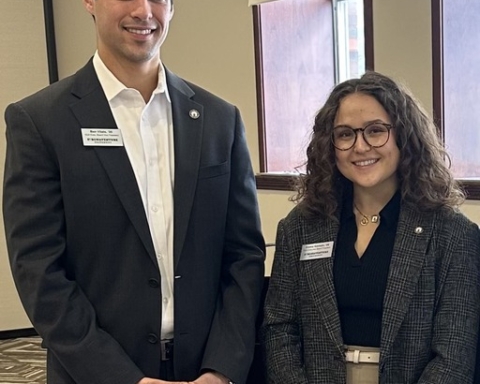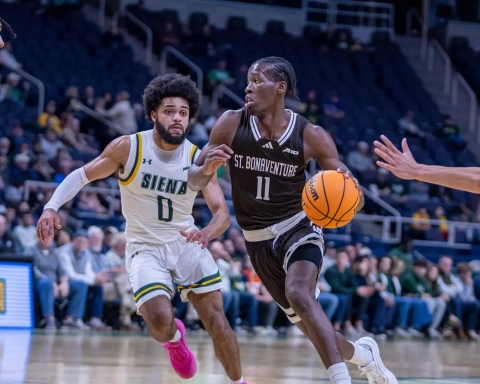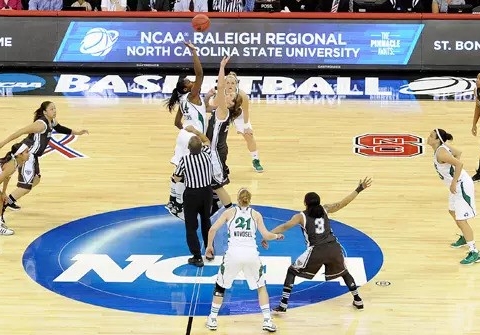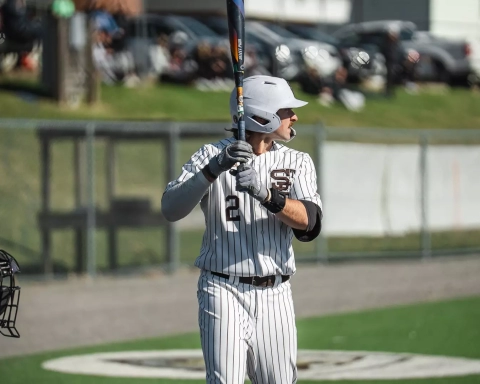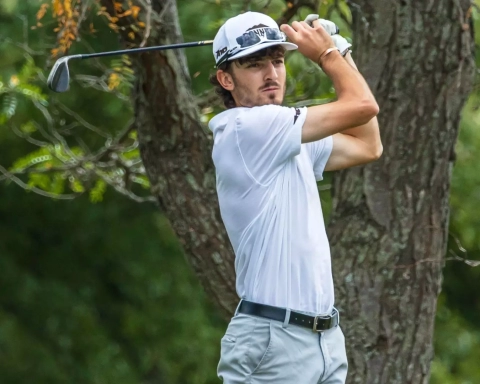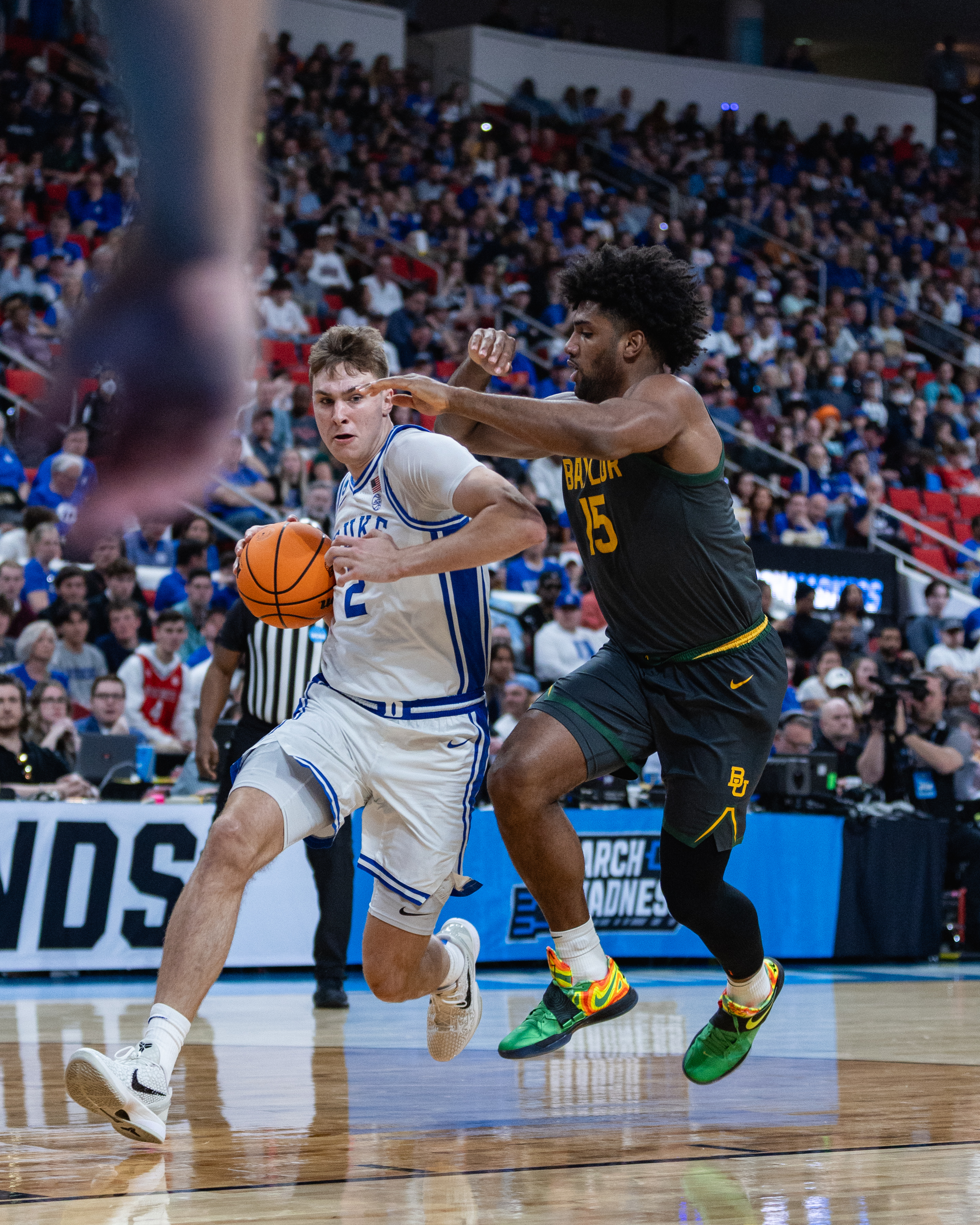Social distancing requirements are adding a new wrinkle to offseason workouts
By Tommy Valentine, Staff Writer
It used to be that the toughest part of preseason workouts for athletes at St. Bonaventure was avoiding the snooze button on their blaring alarm at 6:00 a.m.
Picture the toughest pre-pandemic workout you’ve had in recent memory: hands on your hips, sweat beating down your face, panting as you try to push out that last bench press or complete that final minute on the treadmill. Now picture yourself in that same situation, but for the entirety of your workout, you had a mask on that was collecting sweat, obstructing your breathing and irritating your skin. That is exactly what athletes across the country have been enduring for weeks, as offseason workouts have ramped up with the postponement of the fall season in New York State.
“It sucks. They hate it,” said SBU’s Director of Strength and Conditioning Darryn Fiske on how athletes have had to adjust to training with a mask.
Athletes must abide by the same social distancing guidelines NYS implemented in the spring: they are required to keep a distance between teammates and/or coaches of at least six feet, and if a situation arises where they are unable to social distance, a facial covering must be worn at all times.
While wearing facial coverings during a workout may reduce the potential spread of the coronavirus, it also brings other health risks into play.
Included in an article from FoxNews.com was an interview with Jaclyn Fulop, owner of Exchange Physical Therapy Group and a board-licensed physical therapist, with over 10 years of clinical practice in sports medicine and orthopedic rehab. She is also the. Fulop detailed some of the dangers that could arise from strenuous workouts while wearing a mask, including reduced oxygen flow and an increase in carbon dioxide inhalation. She also explained how a sweaty mask is significantly more susceptible to microorganism growth.
At the end of week three for the fall semester, almost every athlete at SBU has experienced a “masked workout,” and the reviews have been as expected: largely negative.
“When I’m wearing a mask while training, I find myself out of breath very quickly,” said Ryan Kunkle, a junior midfielder and forward on the women’s soccer team. “Also, the sweat gets soaked up in my mask, which really starts to irritate my skin and bother me while practicing.”
There’s no denying the situation these athletes find themselves in is less than ideal. However, guidelines have been put in place to allow athletes time to get acclimated with and adjust to the ‘new normal’, before the intensity of their workouts reaches their usual rigorous level.
Fiske explained that during conditioning, he and his staff follow the instruction of the return to play joint statement, administered by the Collegiate Strength and Conditioning Coaches Association (CSCCa) and National Strength and Conditioning Association (NSCA), which implemented the 50/30/20/10 rule. This rule requires week one conditioning for teams to start at 50% of whatever activity the team initially would have done in the first week of training, and then move on to each successive percentage in the following weeks.
Fiske provided the example of a team having a conditioning test in week one comprising 16, 200-yard shuttles. The trainer or coach can either choose to cut the reps by 50%, increase the time needed for the drill by 50%, or up the rest time by 50%. At the end of four weeks, a team should be able to begin conditioning at the full level.
Weight training requirements have also been adjusted, and in that regard, Fiske uses the Frequency, Intensity, and Time (FIT) rule, which starts athletes at lighter weights than they may typically be used to. The FIT rule requires two weeks of adherence before weight progression is allowed.
Ideally, athletes will be more comfortable working out with a face covering after the time periods of those two rules expire, but realistically, having an obstructive apparatus on your mouth while breathing heavily is something you simply can’t get used to. And the mental toll the mask takes on an athlete is as significant as the physical toll.
“When you sit there and think about wearing a mask the whole time, then it’s in the back of your mind while you’re trying to work out. That can cause an interference,” said Lance Sininger, a sophomore member of the men’s golf team.
Despite all the grievances and complaints from players, the harsh reality is that masked workouts are part of the ‘new normal’ for the foreseeable future. Fiske believes the best way to remedy the situation and alleviate the health risks mentioned earlier is simply by getting some fresh air.
“We alleviate the problems by social distancing and by training outside,” said Fiske. “If we are out on the turf and I have them socially distant, they can pull their mask down. When we are in the weight room or underneath the tent, masks are on at all times. That’s why we’re outside all the time.”
Despite all the negative aspects of mask wearing and added obstacles the social distancing guidelines have thrown at athletes, Fiske is confident that when the time comes for teams to start their seasons, especially the fall and winter teams, players will be more prepared and better conditioned than if the seasons had started on time.
“I work with our men’s basketball team; I think we’re going to be in better shape than we have in the past,” said Fiske. “They’ve been here together as a group for so long, and they’ve been under my guidance for so long, that we’re going to be in better shape.”
Until the day comes when social distancing and mask wearing is a thing of the past, Fiske urges athletes to continue to comply with NYS guidelines and the rules he and his staff have put into place, because the fate of collegiate athletics depends on it.
valenttr19@bonaventure.edu


